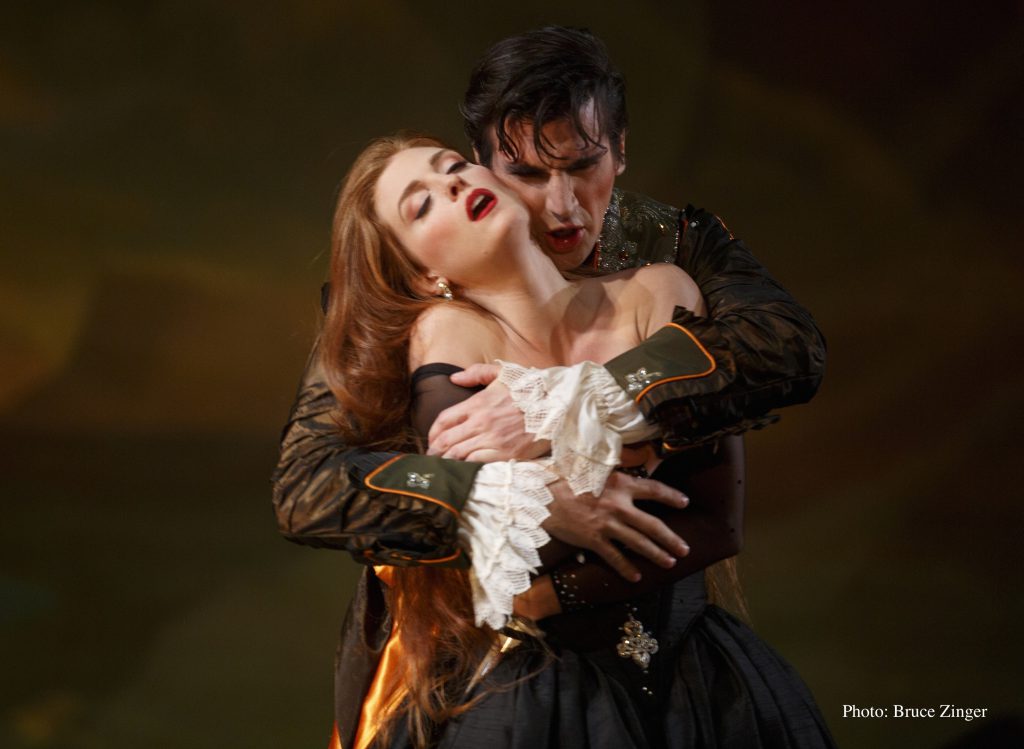The Baroque came late to England. 18 years of suffocating puritanical rule marked by a vicious Civil War and the savage execution of a king had left the nation nervous and unsure of its destiny.
In 1660, a disillusioned Parliament restored the monarchy in the wake of Oliver Cromwell’s death. The country was hurled fast forward into the historical mainstream. French dancers and violinists, Italian virtuosi, Continental instrument makers, all flooded into London, beneficiaries of Charles II’s taste for the arts sampled in exile.
A youthful Henry Purcell soaked up every sight and sound. Odes and elegies, sacred anthems, marches, dances, theatre music, for two brief shining decades prior to his premature death at 36, Purcell was the very embodiment of late 17th century musical style and entertainment for courtier and commoner alike.
Turning a fresh page in Purcell’s well-thumbed play book, Opera Atelier brings a stirring, heartfelt sensibility to a smartly updated, period-inspired presentation of the composer’s landmark Dido and Aeneas, the first truly noteworthy opera written in the English language.
Commissioned by an elite girls school in Chelsea, unveiled on its premises in 1689, Purcell and librettist Nahum Tate based their crisp, 2-act chamber piece on a peripheral episode in Virgil’s Aeneid, a well-known classic in their day.
After long years of waging war, ever-wandering Aeneas, vanquished Trojan champion, is shipwrecked on the shores of Carthage. Encountering the dashing adventurer, Dido, noble queen of the land, casts nagging feelings of apprehension aside. Powerless in the face of Juno and Cupid’s machinations, she and Aeneas fall feverishly in love. A band of troublemaking witches — an all new addition to the tale in Purcell’s rendering — conspires to thwart the happy pair, invoking the threat of Jove’s wrath if Aeneas fails to fulfill his true destiny. The mighty god has ordained that the bold seafaring hero shall found Rome. He and his shipmates dutifully set sail for its fabled coast. Dido, bitter and bereft, is engulfed by grief. Dagger in hand, surrendering to her fate, the proud queen kills herself.
As crackingly entertaining as only melodrama can be, Dido and Aeneas is hardly a narrative triumph. Nahum Tate was no John Dryden, the slick professional poet/playwright who would pen Purcell’s follow-up theatrical venture, the semi-opera King Arthur two years later. Seen simply as story, Dido and Aeneas can seem distinctly giddy, even shallow at times. Aeneas has no discernible solid centre as a character. What the work does possess in limitless abundance, however, qualities that make Dido and Aeneas a masterpiece, are its relentless energy and surging musical inventiveness.
Purcell was a master at harmonizing the wealth of French and Italian influences swirling around him in the late 1600s. The overture to Dido and Aeneas with its sinuous chromaticism is decidedly Lully-esque. What comes next, however, promptly presses the artistic reset button. Belinda’s stern exhortation to Dido, Shake the clouds from off your brow seguing into the brilliantly incorporated chorus, Banish sorrow, banish care, has almost hymn-like force, a stern Calvinist-inspired sermon on queenly behaviour. The first of Dido’s two touching laments, Ah! Belinda, I am prest, that immediately follows overflows with moving Italianate melisma.
Lyrical solos, vivid recitatives choruses, dance music, folk songs, all underlaid with a strong, typically English emphasis on rhythm, Purcell spotlights and synthesizes everywhere.
Never has Dido and Aeneas sounded more treasured, more loved than in Opera Atelier’s stunningly affective summoning of the composer’s genius. This exquisitely compact 90-minute jewel box of a production positively sparkles.
But this is no fragile museum piece locked in a dusty showcase.
The Prologue to Dido and Aeneas, included in the sole surviving copy of an 8-page libretto likely printed sometime after the opera’s low key premiere, quickly slipped into oblivion. Purcell’s manuscript score was lost. No music has been found to date in the composer’s hand and none whatsoever related to the opening as originally written.
For virtually the first time in over 320 years, the Prologue is back, reconstructed in stylish Baroque hybrid form as might well be expected from Opera Atelier’s groundbreaking artistic director, Marshall Pynkoski.
Warmly responding to queries, music director and conductor David Fallis has provided Opera Going Toronto with a wealth of perspective. All of it needs to be shared.
Of the 8 themes associated with the restored curtain raiser, all but one of them have been plucked from a collection of music with overt links to the Restoration stage, Purcell’s Ayres for the Theatre. The only piece not by the landmark English composer is the second segment heard, a blistering storm motif written by Purcell’s cross-Channel contemporary, Marin Marais. “The best storm music in all of Baroque rep for my money,” Fallis insists.
He and the Tafelmusik Baroque Orchestra bring it to life. From curtain to curtain, bar after bar, the practiced ensemble thrills.
Like the Prologue’s reminted accompaniment, text, rousingly spoken by actor Irene Poole, is simultaneously both old and new. Urgent blank verse excerpted from a contemporary English translation of the Aeneid by Robert Fagles replaces Nahum Tate’s florid couplets. Essential backstory is sharply conveyed.
Pynkoski’s staging is no less eloquent.
Dance is very much centre stage in this vital, animated Dido and Aeneas. Choreographer Jeanette Lajeunesse-Zingg floats her superb company on a tide of fluid movement. The swirling Groves Dance, a tricky brisk Baroque ballet, is given a breezy airing. Frolicking with castanets, Lajeunesse-Zingg and partner captivate, dancing to a 17th century Spanish Folly custom-arranged by Fallis, charmingly played on fiddle and period guitar. The ingenuity and skill on show are magical.
Appearing as Dido, mezzo-soprano Wallis Giunta weaves her own brand of enchantment with a striking, vibrant depiction of Purcell’s doomed queen. The namesake roles of Dido and Aeneas, invoked as a matched pair in the title, are far from equally balanced in terms of operatic demands. Purcell’s taut, compressed tragedy places Dido squarely in the eye of a raging emotional tempest. Giunta infuses the character with enormous purpose and resolve. Dignity and poise pour from her voice, slapping down Aeneas’ hypocrisy, defying him, clear-eyed and independent. Remember me, the inexpressibly haunting aria that closes Dido’s life, a simple, soaring release of spirit, is poignantly rendered by this exceptionally accomplished artist.
Tenor Christopher Enns sings Aeneas, deftly transitioning over the course of a surprisingly limited number of unadorned recitativi secci from bluster and swagger to confusion and ultimately pathos.
Soprano Meghan Lindsay is Belinda, sister to Dido, confidante and critic. Vocally silvery and gleaming, the gifted early opera specialist lights up this shimmering Dido and Aeneas, her character a key player in building and rebuilding musical momentum scene after scene. Forever in command, Lindsay clearly glories in her role.
As Bedlam, the bearded Sorceress, mezzo Laura Pudwell, communing with Witches, sopranos Ellen McAteer and Karine White, essentially steals the show. The cackling trio’s deliciously evil antics raise villainy to an art.
Cory Knight is a jaunty Baroque vaudevillian mariner, his little hornpipe, Come away, fellow sailors an absolute delight.
Lifting their voices to the Elgin Theatre’s gilded rafters, the 22 members of the Toronto Children’s Chorus Choral Scholars contribute a fine, upswelling sweep of sound. Dido and Aeneas was composed with young singers in mind, many of whom took part in its inaugural performance. A profound sense of historical continuity is very much present here. And most welcome.
Producers of Baroque musical theatre had high expectations when it came to hiring casts. Performers were expected to be as versatile as they were virtuosic. Opera Atelier has clearly adopted a similar point of view. This splendid, exuberant Dido and Aeneas is an exercise in artistic multi-tasking. Singers dance. Dancers sing. Choristers create sound effects.
This is a remarkable piece of work. The company is to be roundly cheered.


